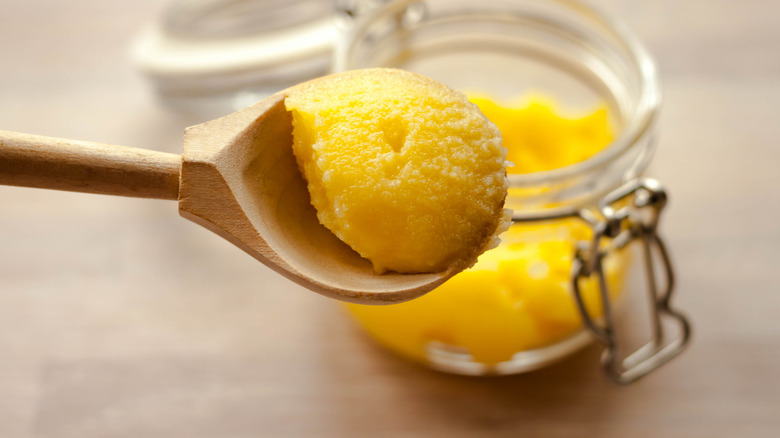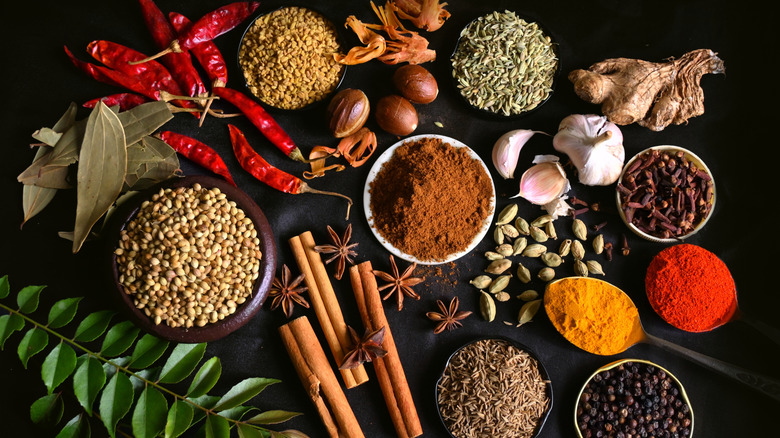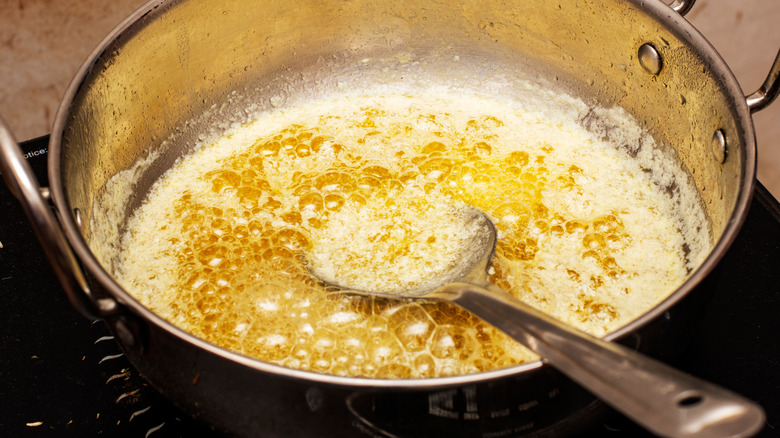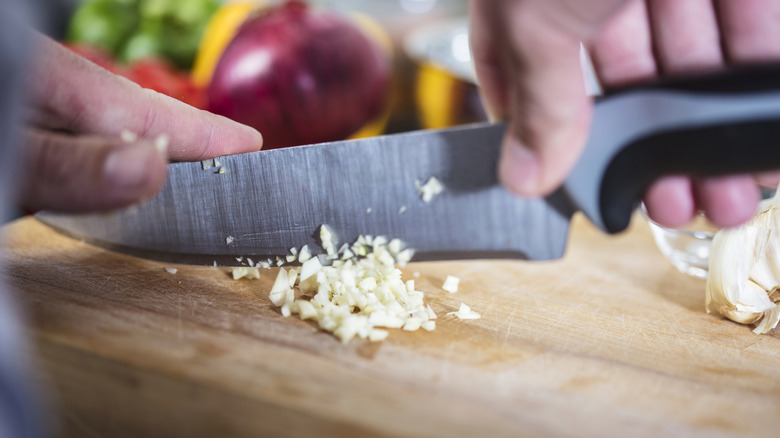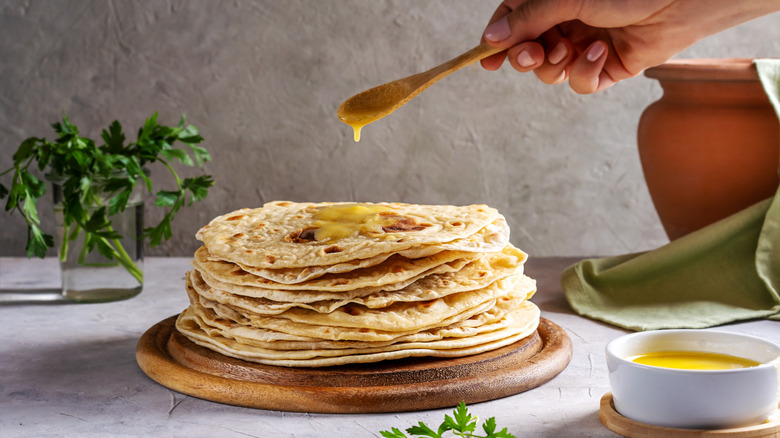The Right Way To Make Infused Ghee For Naan According To A Pro
We may receive a commission on purchases made from links.
Besides dipping naan in some savory dal makhani, another common way to enjoy this fluffy bread is by brushing it with some ghee. For those who don't know, ghee is a type of concentrated clarified butter made by separating the fat from butter's excess water and milk fats. Essential in South Asian cuisine, ghee is nutty and fragrant, and the perfect ingredient to bring additional warmth and flavor to a whole slew of dishes. With its high concentrations of Vitamin A and omega-3 acids, you can use it in place of regular butter too.
While plain ghee is a common condiment to pair with naan, there are some ways to elevate ghee to take your meal to the next level. To give us some tips on how to do just that, Chowhound spoke with chef Varun Inamdar, the Chef and Owner of 27 Degrees West in Singapore, Anokhi Bar & Grill in Shanghai, and New Light Sopore in Kashmir. He also runs the YouTube channel Rajshri Food, teaching home chefs how to make delicious vegetarian dishes. For an elevated naan experience, Inamdar suggests infusing ghee with fragrant spices and herbs for some added flavor. As he says, "Brushing naan with flavored ghee adds a wonderful depth." So without further ado, here are some tips on doing just that, like a pro.
Choose the right spices and herbs for you
When it comes to making your infused ghee taste right, picking out the right herbs and spices to start with is key. When choosing a recipe, it's always best to select spices that will best complement the rest of your dish, so consider what you've got cooking to see what will match. Varun Inamdar notes, "Common choices include cumin seeds, nigella seeds (kalonji), garlic, and fresh herbs like cilantro or mint."
Aside from the classic herbs and spices, Inamdar has a few specific recommendations that can really take a basic plate of naan to the next level. "For a more aromatic touch," he suggests, "consider using dried herbs like oregano or thyme." As for other ingredients Inamdar personally prefers to use in ghee, he has a few specialty favorites that he serves at his restaurants. "I do black pepper ghee and truffle ghee in my restaurant named 27 Degrees West in Singapore," he said. For those who like to keep it simple, though, he also serves naan plain with butter, or with garlic.
Infuse ghee the right way
Once you've picked out the right ingredients, it's time to start cooking. Heat up ghee in a pan first to get things started. From there, add in your aromatics of choice. According to Varun Inamdar, patience is key in this process, as spices need time to bloom to get the best flavor from them. "Heat the ghee gently in a pan," he says, "add whole spices like star anise, cloves or cinnamon and let them sizzle for a few seconds to release their flavors." Just be careful not to cook them for too long, or those fragile spices might burn.
While mixing these ingredients together, Inamdar also encourages chefs to enjoy the cooking process. The journey is part of the fun, and once you've made infused ghee once, you can branch out to try other unique flavor combinations."Don't hesitate to experiment with different spice combinations or ratios to find the flavor profile you enjoy most," he says.
Be careful about timing
Another of Varun Inamdar's tips on infusing ghee is to stay knowledgeable about your ingredients. For example, as any expert will know, cooking garlic needs some care. Timing is key, as sizzling garlic up in a pan for too long can lead to bland or burnt-tasting dishes. "If you're using garlic, crush or finely chop it and add it after the whole spices," Inamdar advises. "Cook it until it's golden, then remove it from the heat to avoid bitterness."
Once you've added all those dried herbs and spices, it's time to talk about fresh herbs. Because new greens are so delicate, they should be the last things you throw in. "Fresh herbs can be added at the end of the cooking process to maintain their vibrant color and flavor," Inamdar says.
To strain or not to strain?
To finish off the process of making an infused ghee, you'll need to prep it for storage. How exactly you choose to do that depends on the flavor you want. "If desired, strain the ghee to remove the solids before using it. Or leave them in for added texture and flavor," Varun Inamdar says. The choice is up to you.
If you don't plan on eating it right away, it's important to store your ghee properly. "Infused ghee can be stored in an airtight container in the fridge for a few weeks," Inamdar advises. If you opt for an open container instead or leave ghee out exposed to air, its shelf life will decrease dramatically. Once you're finally ready to reap the benefits of your labor and use the infused ghee, be careful. "Just reheat it gently before using," recommends Inamdar. The word gently is key here. Even though ghee has a higher smoke point than other fats, it can still burn (as can any ingredients that weren't strained out), so low heat is the way to go.
Ghee is a staple in Indian cuisine, as you'll see if you look through a few Indian cookbooks, and infusing it can give a unique depth of flavor to a meal. It's easy to buy ghee online, such as this 4th & Heart Original Grass-Fed Ghee, and it's not difficult to try infusing some yourself, to see just how much it elevates a batch of naan. Just stick to these expert tips so the process remains seamless.
